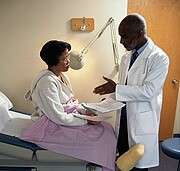(HealthDay)—For urban women aged 25 years and older, the prevalence of Chlamydia trachomatis (CT) and Neisseria gonorrhoeae (NG) is low, and women may be overscreened, according to a study published in the January issue of the American Journal of Obstetrics & Gynecology.
Jaleesa A. Jackson, from the Johns Hopkins University School of Medicine in Baltimore, and colleagues examined the prevalence of CT and NG among older women aged 25 years or older who were tested or screened for CT/NG. Data were collected from 658 eligible women.
The researchers found that the median age of those positive for CT/NG was 30 years. The prevalence of chlamydia was 1.7 percent and that of gonorrhea was 0.3 percent. Symptomatic women were three times more likely to test positive for CT/NG after adjustment for age (adjusted odds ratio, 3.4), while sexually transmitted infection (STI)-exposed women were 10 times more likely to test positive (adjusted odds ratio, 10.0). There was no correlation between nonmonogamous relationship, abnormal examination results, and previous STI and CT/NG among asymptomatic non-STI-exposed women. Twenty-one percent of women experienced overscreening, and were all menopausal, had a hysterectomy, or were aged older than 40 years.
"CT/NG prevalence among older women was low, even in a community of high STI prevalence," the authors write. "More than 20 percent of women could have avoided CT/NG evaluation without impacting the detection of positive results in our clinic cohort. Overscreening occurred among asymptomatic, non-STI-exposed women who were menopausal, had a hysterectomy, and were >40 years old."
More information:
Abstract
Full Text
Journal information: American Journal of Obstetrics and Gynecology
Copyright © 2015 HealthDay. All rights reserved.





















